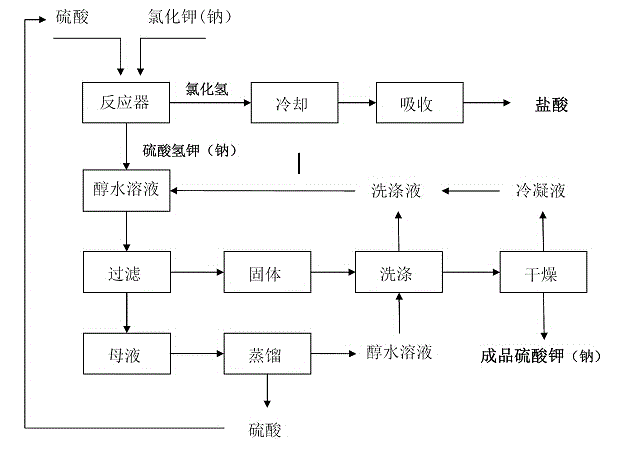Method for producing potassium sulfate or sodium sulfate by potassium chloride or sodium chloride and sulfuric acid
A technology of potassium chloride and potassium sulfate, applied in the fields of inorganic salt industry and fertilizer industry, can solve problems such as difficulty in single furnace production capacity, large energy consumption, equipment corrosion, etc., and achieve light equipment corrosion, low reaction temperature, and fast reaction speed. Effect
- Summary
- Abstract
- Description
- Claims
- Application Information
AI Technical Summary
Problems solved by technology
Method used
Image
Examples
Embodiment 1
[0024] Example 1: A new method for producing potassium sulfate (sodium) using potassium chloride (sodium) and sulfuric acid as raw materials, technical process reference figure 1 .
[0025] Put potassium chloride (sodium) with a content of 95% and industrial sulfuric acid with a concentration of 98% according to the ratio of 1:1, and put them into the reactor under continuous stirring. The reaction temperature is controlled at 220°C, and the reaction is carried out for 30 minutes. , Potassium bisulfate (sodium) generated after the reaction is completed is atomized and sprayed into 70% ethanol aqueous solution, and filtered to obtain solid and mother liquor. The solid was washed with 70% ethanol aqueous solution, dried at 110°C, and crushed to obtain the finished potassium sulfate (sodium). The above mother liquor is distilled and separated at a temperature of 110°C to obtain alcoholic aqueous solution and sulfuric acid. The sulfuric acid is recycled and the alcoholic aqueous ...
Embodiment 2
[0026] Embodiment two: adopt potassium chloride (sodium) and sulfuric acid to be the new method of raw material production potassium sulfate (sodium)
[0027] Put potassium chloride (sodium) with a content of 95% and industrial sulfuric acid with a concentration of 98% according to the ratio of 0.9:1, and put them into the reactor under continuous stirring. The reaction temperature is controlled at 210°C, and the reaction is carried out for 30 minutes. , Potassium bisulfate (sodium) generated after the reaction is completed is atomized and sprayed into 70% ethanol aqueous solution, and filtered to obtain solid and mother liquor. The solid was washed with 70% ethanol aqueous solution, dried at 130°C, and crushed to obtain the finished potassium sulfate (sodium). The above mother liquor is separated by vacuum distillation at 80°C to obtain alcoholic aqueous solution and sulfuric acid. The sulfuric acid is recycled and the alcoholic aqueous solution is recycled or used to wash so...
Embodiment 3
[0028] Embodiment three: adopt potassium chloride (sodium) and sulfuric acid to be the new method of raw material production potassium sulfate (sodium)
[0029] Put potassium chloride (sodium) with a content of 95% and industrial sulfuric acid with a concentration of 93% according to the ratio of 0.8:1, and put them into the reactor under continuous stirring. The reaction temperature is controlled at 180°C and reacted for 30 minutes. , Potassium bisulfate (sodium) generated after the reaction is completed is atomized and sprayed into 80% ethanol aqueous solution, and filtered to obtain solid and mother liquor. The solid was washed with 80% ethanol aqueous solution, dried at 120°C, and crushed to obtain the finished potassium sulfate (sodium). The above mother liquor is distilled and separated at a temperature of 105°C to obtain alcoholic aqueous solution and sulfuric acid. The sulfuric acid is recycled and the alcoholic aqueous solution is recycled or used to wash solid potass...
PUM
 Login to View More
Login to View More Abstract
Description
Claims
Application Information
 Login to View More
Login to View More - R&D
- Intellectual Property
- Life Sciences
- Materials
- Tech Scout
- Unparalleled Data Quality
- Higher Quality Content
- 60% Fewer Hallucinations
Browse by: Latest US Patents, China's latest patents, Technical Efficacy Thesaurus, Application Domain, Technology Topic, Popular Technical Reports.
© 2025 PatSnap. All rights reserved.Legal|Privacy policy|Modern Slavery Act Transparency Statement|Sitemap|About US| Contact US: help@patsnap.com

